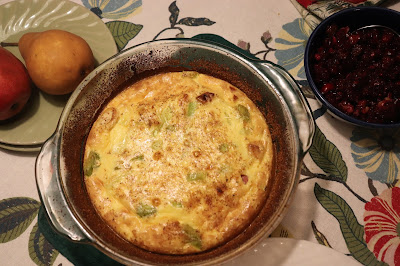Rather than saving the end result for the finale, I’m revealing it here right up front. This was my version of savory clafoutis featuring ham and leeks.
The classic clafoutis comes from the Limousin region of France and features unpitted fresh black sweet cherries. I hadn’t realized there were so many variations, but then, it’s possible that Christophe Felder, the well-known French pâtissier, invented the many versions in his book, Clafoutis de Christophe. At any rate, the two major divisions are sweet clafoutis (sucrés) and savory (salés), the latter particularly intriguing to both human members of our household and a completely new idea to me.
With so many mouth-watering variations offered, it was hard to choose which to try first. I leaned toward ham and leeks, since we like both. I also liked the attractive bundles of slivered leeks wrapped in slices of ham but thought the ham was not quite in scale (it looked somewhat gross and heavy, even in the beautiful color photograph) and that prosciutto would be better – thin slices of meat, slender slivers of leak. But my quarantine kitchen partner vetoed prosciutto (“too fatty,” he says), so I compromised by cubing the ham and slicing the leeks into rounds, more in the style of the Clafoutis poireaux et lardons.
Using this cookbook presented multiple challenges. (1) To begin with, every word is in French, and there were words whose meaning I had to seek in a dictionary, e.g., chapelure. Would you have known that one? (2) Second necessity was that of converting metric measurements to American. Twenty-five centileters = 1 cup; 150 grams = 2/3 cup; etc. (3-4) Then there was oven temperature, which I had to convert from Celsius to Fahrenheit and adjust the Fahrenheit temperature for high altitude – and I cannot tell you how many times I calculated and checked and re-checked the oven temperature for my clafoutis until finally, after a careful search through many recipes in the book, I realized that the savory recipes required baking at about 100ºF higher than the sweet recipes.
I guess there was a small fifth challenge, as French crème fraîche is not readily available in the U.S. While it is possible to make a substitute, using sour cream or buttermilk or yogurt, I was happy to find crema Mexicana locally, which fit the bill to a T. One cup of crema, one cup of milk (I used evaporated milk straight from the can), two whole eggs, and two egg yokes, beaten together with slightly less than 2-1/2 teaspoons (10 grams) cornstarch, and this, with the addition of salt and pepper, is poured over the ham and leaks in a baking dish that has been buttered and dusted with fine crumbs. The next time I try a savory clafoutis I’ll add grated Parmesan to the fine crumbs, because that crispy crust could only be improved by cheese flavor.
After thirty to forty minutes in a hot oven (425ºF here in the mountains), the dish puffs beautifully. It has the lightness of a souffle and yet the smooth texture and richness of a baked custard – which is what made the nutmeg dusted on top even more appropriate than I imagined when the idea came to me.
Remember that fresh, uncooked, spicy cranberry-walnut relish from Christmas dinner? Cold and crisp, it was an ideal complement to the hot savory custardy main dish.
I feel so much like Julia Child (a rare feeling for me) in offering this recipe to you (well, it is actually Christophe Felder’s offering, not mine, but I, like Julia, have made it available to American cooks) that I can only close today by echoing Julia: “Bon appétit!”











Looks delicious. You nailed it, if it turned out with a custard texture. Bon Appétit.
ReplyDeleteAmazing!
ReplyDelete